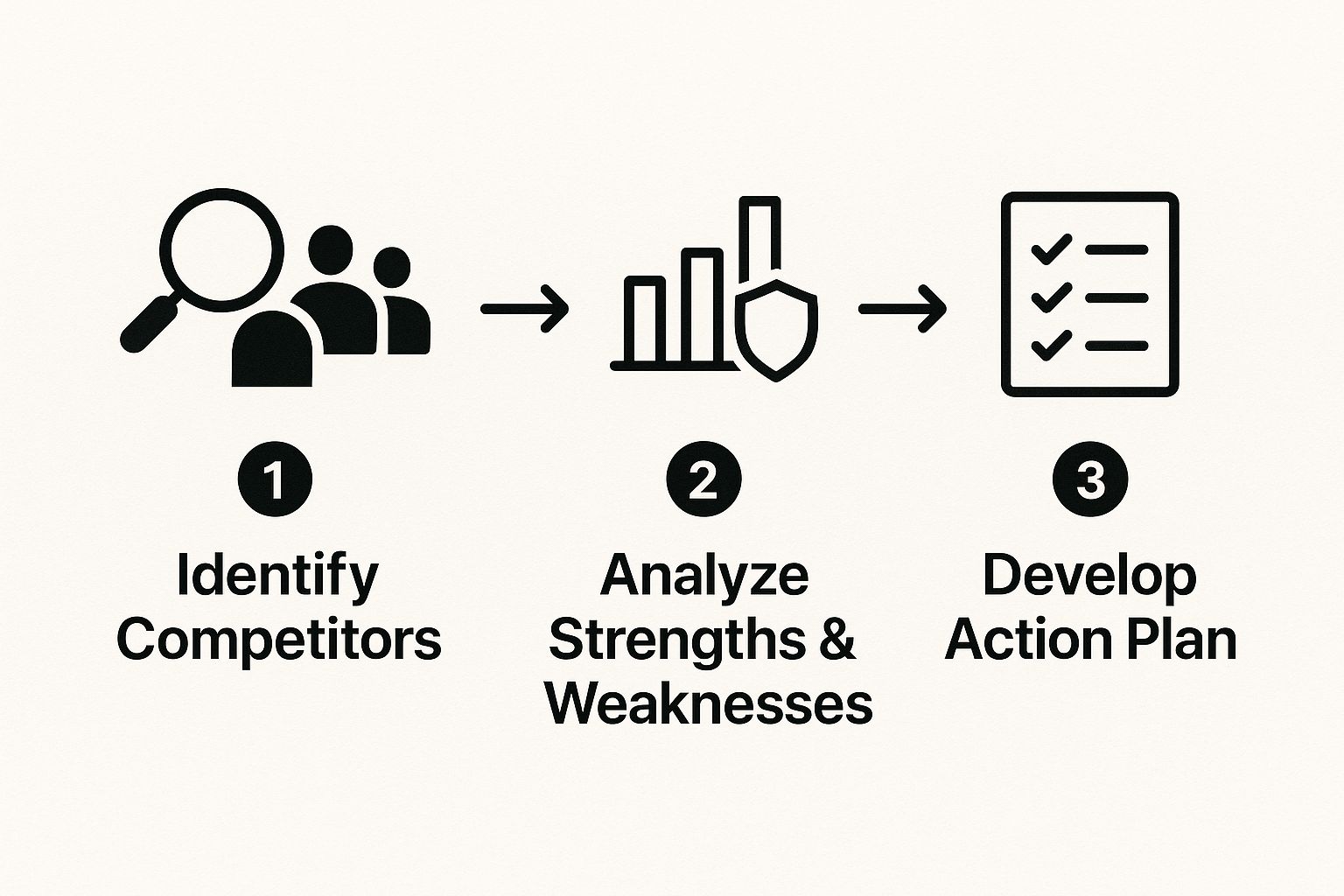So, what exactly is a competitive analysis framework? Think of it less as a stuffy business school concept and more as your team's playbook for outsmarting the competition. It’s the structured process you use to find, understand, and, most importantly, act on information about your rivals.
This isn't about some cloak-and-dagger spying operation. It's about building a repeatable system that turns random competitor intel into a real, sustainable advantage.
Why Your B2B Sales Team Can't Afford to Skip This
Let’s be real. Too many B2B sales teams run on gut feelings and secondhand stories when it comes to the competition. A rep loses a deal, and the reason is always, "They undercut our price." But is that the whole story? Where's the proof?
This kind of reactive, anecdotal approach is a recipe for disaster. It leads to shaky messaging, deals slipping through your fingers, and constantly being caught off guard by a competitor's new move.
A solid competitive analysis framework flips the script, moving your team from reactive to proactive. Instead of just documenting why you lost a deal, you start predicting your competitors' moves. You arm your reps with hard, data-backed talking points to counter claims before they even come up. Suddenly, you're not just defending your turf—you're strategically poking holes in their pitch while playing up your own unique strengths.
From Guesswork to a Strategic Advantage
The idea of formalizing how you track competitors isn't new, but how you execute it makes all the difference. The fundamental flow is simple enough, breaking a big process down into three core stages.

This visual drives home the most critical point: collecting data is pointless if you don't turn it into an action plan your sales team can actually use on a call. It's a method that has been polished for decades by top-tier consulting firms for a reason—it works.
These frameworks typically revolve around three fundamental stages: Assess, Benchmark, and Strategize. This structured process helps companies continuously monitor rivals' moves and market dynamics, which is crucial in highly dynamic sectors.
You start by identifying who you’re really up against in the Assess stage. Then, you dig into their products, pricing, and weak spots in the Benchmark stage. Finally, you use all that intel to build smarter sales strategies in the Strategize phase. This stops you from chasing irrelevant details and gives your team insights they can trust. For a deeper dive, check out the resources on building a competitive framework over at AlphaSense.com.
Core Components of a Modern B2B Competitive Framework
So, what does this actually look like day-to-day? A truly effective framework isn't just a one-off report; it's a living system built on a few essential pillars. These components work together to paint a clear picture of the competitive landscape and tell you exactly what to do about it.
Here’s a simple table breaking down the key pieces you’ll need to build your own framework.
| Component | Objective | Key Activities |
|---|---|---|
| Competitor Identification | To define the complete competitive landscape. | Listing direct, indirect, and emerging competitors; segmenting them into tiers. |
| Intelligence Gathering | To collect actionable data on rivals. | Monitoring pricing pages, analyzing marketing collateral, tracking customer reviews. |
| SWOT Analysis | To pinpoint specific strengths and weaknesses. | Identifying product gaps, messaging vulnerabilities, and operational advantages. |
| Strategic Action Plan | To arm the sales team with winning tools. | Creating competitive battle cards, developing counter-messaging, and training reps. |
Putting these pieces into play creates a dynamic system—not a dusty report that sits on a shelf. It becomes the engine that fuels your bottom line and gives your sales reps the confidence they need to win, one conversation at a time.
Identifying Your True Competitors Beyond the Obvious
When you start digging into competitive analysis, it's easy to get tunnel vision. Most sales teams only think about the handful of names that pop up on calls every single day. That's a huge mistake.
Your real competitive landscape is much broader—and way more complicated—than just the companies selling a carbon copy of your product. To build a strategy that actually works, you have to look past the usual suspects. Often, the biggest threats (and the best opportunities) are hiding in plain sight, solving the same core problem for your customers in a completely different way.
Moving Beyond Direct Rivals
A simple way to get a clearer picture is to start categorizing the competition. This isn't just busywork; it brings immediate focus to your analysis. It stops you from wasting precious time dissecting a company that isn't a real threat to your bottom line.
Think about sorting them into three buckets:
- Direct Competitors: These are the ones you know inside and out. They sell a similar product to the same audience. Think Trello vs. Asana. They're head-to-head rivals.
- Indirect Competitors: These guys solve the same problem, but with a different tool. For a project management tool like Trello, an indirect competitor could be Slack. Both are about team collaboration, but one uses visual boards while the other is built around messaging.
- Emerging Competitors: These are the new kids on the block. They might be small now, but they often have an innovative approach or a unique value proposition that could disrupt the market. A great example is how Airtable came onto the scene as a super-flexible alternative to the old guard of project management tools.
Using this tiered approach makes sure your analysis is comprehensive, not just a knee-jerk reaction to the loudest players in the room.
How to Uncover the Full Picture
So, how do you actually find these hidden competitors? Your best source is already on your payroll: your sales and customer service teams. They’re on the front lines every day, hearing exactly what other solutions your prospects are kicking the tires on.
A great place to start is just by asking your sales reps, "Who else did the prospect mention?" If you do customer interviews, ask new clients which other brands they checked out before signing with you. You'll be surprised by the indirect and emerging names that come up.
Beyond your internal teams, good old-fashioned keyword research is a goldmine. Run a quick search for your main industry terms. Any company that consistently ranks for the keywords you’re targeting is a competitor, period. It doesn't matter if their product looks different on the surface.
This kind of intel isn't just for battle cards. Understanding who's capturing your audience's attention online is crucial for improving your own B2B sales lead generation. Once you know who you're really up against, you can fine-tune your messaging and outreach to stand out.
Gathering Intelligence That Actually Wins Deals
Let's be honest. A competitive analysis framework is only as good as the intel you feed it. If you're just scraping a competitor's homepage tagline or making a basic feature checklist, you're not giving your sales team the ammunition they need to win.
You have to go deeper. The real goal isn't just knowing what your competitors offer, but understanding how they sell it, who they're selling to, and—most importantly—where they're dropping the ball. This means getting past the polished marketing slicks and finding the unfiltered truth.
Uncovering Their Go-to-Market Playbook
To really get under the hood of a competitor's strategy, you need to analyze their sales motion. And I'm not just talking about a quick glance at their pricing page. It's time to put on your detective hat.
One of the most revealing places to look? Their job postings. Seriously. Are they suddenly hiring 10 enterprise reps in a new territory? That's a massive tell for an expansion play. Are they looking for engineers with a niche, new skill set? You might be looking at a major product pivot 6 to 12 months down the line.
By analyzing job offers, we can often predict a competitor's next actions. For example, recruiting a large number of engineers suggests new products are under development, whereas hiring salespeople in a new country means the company is gearing up to break into new markets.
This isn't just interesting trivia; it's proactive intelligence. It lets you prep your own counter-moves long before they make a public announcement. You can arm your reps with preemptive talking points and even fine-tune your own roadmap.
Deconstructing Their Messaging and What Customers Really Think
Understanding how your competitor talks about themselves is crucial for crafting your own story. But don't stop at their website copy. You need to dig into their entire content ecosystem to see the full picture.
Here's where I'd start digging:
- Marketing Collateral: Get your hands on everything you can. Download their whitepapers, sit through their webinars, and dissect their case studies. What pain points do they hammer on? What specific words do they use to frame their benefits?
- Customer Reviews: This is where the gold is. Spend time on G2, Capterra, and TrustRadius. Look for patterns. If you see ten different customers complaining about a "clunky UI" or "slow support," you've just found a powerful wedge for your sales team.
- Social Media: Watch how they handle themselves in the wild. What questions are prospects asking on their posts? How do they respond to public complaints? A solid social media analytics report template can help organize your findings and spot trends in how they engage with their audience.
This process gives you a 360-degree view that moves you beyond features and into reputation. And in a tough sales cycle, reputation is what closes deals. The insights you pull from this become the foundation for killer battle cards, objection-handling guides, and messaging that hits home with prospects weighing their options.
Pinpointing Competitor Strengths and Weaknesses
Once you’ve gathered your intel, you're left with a pile of raw data. The real work is shaping that data into something your sales team can actually use on a call. This is where you translate lists of features and angry customer reviews into a real strategic advantage.
The goal isn't just to know your competitor is "weak" in a certain area. It’s about understanding precisely how that weakness creates an opening for your rep in a live sales conversation.
This is the absolute core of an effective competitive analysis framework. It takes you beyond simple fact-finding and into the realm of strategic application. The classic SWOT analysis (Strengths, Weaknesses, Opportunities, Threats) is a fantastic starting point, but for B2B sales, we need to adapt it. We have to look at everything through the lens of a potential customer's buying decision.
Adapting SWOT for B2B Sales
In the world of sales, a competitor's weakness is only useful if it's a pain point your product solves brilliantly. By the same token, their strength is only a threat if it directly addresses a key reason your target customer buys.
Let's break down how to look at each element for maximum sales impact:
- Strengths: What do they do well that genuinely matters to buyers? This could be a feature everyone loves, a rock-solid brand reputation, or a super flexible pricing model. Your job isn't just to list these, but to arm your team with a counter-argument for each one.
- Weaknesses: Where do they consistently drop the ball? Dig into reviews and look for recurring complaints about their product, their support, or their messy onboarding. These are the specific vulnerabilities your reps can pounce on.
- Opportunities: What market gaps are they completely ignoring? Maybe it’s an underserved industry or a growing customer need their product doesn't address. This is your chance to position your solution as the smarter, forward-thinking choice.
- Threats: What outside factors give them an edge? This could be a huge integration partner, a massive funding round that lets them discount like crazy, or just a legacy brand name that carries a lot of weight in a key market.
A proper SWOT analysis isn’t just an academic exercise—it’s about digging up actionable insights. It’s about knowing what they do well, where they fail, and how you can use that information to win.
This approach transforms your analysis from a dusty report into an active sales tool. It helps you get ahead of objections and proactively frame the conversation around your unique value.
From Analysis to Actionable Angles
The real magic happens when you turn these observations into specific "attack" and "defend" angles for your sales team. This is how your framework becomes a playbook for closing competitive deals. We go into more detail on building these repeatable strategies in our guide to sales process optimization.
Let's walk through a real-world scenario. Imagine you're selling a project management tool. Your main competitor is famous for its massive feature set (a clear Strength). But, as you dig through G2 and Capterra reviews, you spot a pattern: users constantly complain that the tool is "overly complex" and a nightmare to onboard (a critical Weakness).
This insight is pure gold.
Instead of getting into a feature-for-feature battle, your reps now have a sharp, specific angle:
- Attack Angle: "I know Competitor X has a ton of features, but we hear from a lot of their former customers that they only ended up using 10% of them. They said the complexity actually slowed their teams down. Our platform is designed to give you exactly what you need for faster adoption and a much quicker ROI."
See what happened? That simple pivot reframes their biggest strength as a negative. It positions your solution as the practical, efficient alternative. By systematically applying this lens to every piece of intel, you build a powerful arsenal of talking points that help your team navigate competitive situations with confidence and skill.
Turning Your Insights Into a Winning Sales Strategy
All that research and analysis means nothing if you don't act on it. This is where the rubber meets the road—the moment your competitive analysis framework stops being a research doc and starts being a revenue-generating machine.
The whole point is to translate what you’ve learned into real, tangible tools your sales reps can actually use on a call. This isn't about creating a massive report that gathers dust. It's about building a playbook for winning.
Crafting Bulletproof Messaging
So, where do you start? With your messaging.
The best sales messaging doesn’t just explain what you do. It positions your solution as the only logical answer when compared to the competition.
Let's say your analysis shows your biggest rival has a clunky, feature-stuffed product that takes forever to set up. Your messaging should be all about simplicity, speed-to-value, and an incredible user experience. Hammer those points home.
The most effective sales strategies are born from a deep understanding of the competitive landscape. Your analysis shows you where to strike. The real art is turning that insight into a simple, repeatable message your entire team can deliver with confidence.
Every key insight from your analysis needs to map directly to a talking point. This ensures your sales conversations are always strategic, laser-focused on the exact areas where you have a clear and decisive advantage.
Seeing how others have used strategic insights to take over their market can be a huge motivator. For a real-world look at this in action, check out this case study to see how one company managed to dominate the market with strategic insights.
Building Your Competitive Battle Cards
Now for the most practical tool you can give your team: competitive battle cards.
Think of these as one-page cheat sheets that boil down all your analysis into quick, scannable, and actionable talking points. They give reps the confidence to navigate any competitive conversation that comes their way. It’s their secret weapon.
An effective battle card needs to be incredibly easy to scan mid-call and packed with the exact phrases your reps can use. Centralizing this intelligence in an accessible format ensures everyone is on the same page, which is a key function of modern sales engagement platforms.
Here’s a simple, no-fluff template you can use to build out a battle card for each of your top competitors.
Competitive Battle Card Template
This template is designed to be a quick reference, not a novel. It should give your reps exactly what they need at a glance to handle tough questions and position your product as the superior choice.
| Element | Description | Example |
|---|---|---|
| Why We Win | A 2-3 bullet point summary of your core advantages over this specific competitor. Keep it punchy. | – Our platform onboards in hours, not weeks. – We offer dedicated human support, unlike their ticket system. |
| Their Weaknesses | Specific, proven vulnerabilities you can exploit, with supporting proof (e.g., from G2 or Capterra reviews). | "Customers on G2 consistently report their UI is 'clunky' and 'unintuitive', which really slows down user adoption." |
| Objection Handling | Quick "if they say this, you say that" responses to common claims or FUD they might spread. | They Say: "We have more features." You Say: "More features often means more complexity. We focus on the features that actually drive results, which is why our users see ROI 50% faster." |
| Pricing Traps | Hidden fees, surprise charges, or limitations in their pricing model you can warn prospects about. | "Make sure you ask them about overage fees for data storage. We've heard from former customers that it can be a significant unbudgeted cost." |
By equipping your team with these kinds of tailored resources, you're not just throwing data at them—you're handing them a playbook.
This final step is what makes the whole competitive analysis effort worthwhile. It ensures your hard-earned insights directly contribute to closing more deals and winning head-to-head against the competition.
A Few Common Questions We Get
Even the sharpest B2B sales teams have a few questions when they start putting a formal competitive analysis process in place. Here are some of the most common things we're asked about building and using a competitive analysis framework—and how to make sure you get real value from your efforts.
How Often Should We Really Be Updating This Thing?
This is a big one. A classic mistake is treating your competitive analysis like a one-and-done project you can just file away. Markets don't stand still, and neither do your competitors.
As a general rule, a full, deep-dive review every quarter is a solid baseline. This cadence is usually enough to catch major moves, like a new product launch, a big shift in their pricing model, or a new round of funding.
But that doesn't mean you can ignore everything in between. Certain signals need more frequent attention. We recommend keeping a weekly or bi-weekly pulse on things like:
- Social media chatter: What are customers and critics saying right now? Tools like Meltwater can put this on autopilot.
- New job postings: Are they suddenly hiring a dozen engineers for a new "AI" team? Or maybe an entire sales team for a new region? This is a huge tell for where they're headed next.
- Pricing page tweaks: Did they just roll out a new enterprise tier or launch a limited-time promo? These little changes can be early indicators of a bigger strategy shift.
This mix of quarterly deep dives and constant light monitoring keeps your intel fresh, relevant, and genuinely useful.
What Are the Best Free Tools for Competitive Intel?
You absolutely don't need a huge budget to gather powerful intelligence. In fact, some of the best insights come from free sources if you know where to look.
A great starting point is setting up Google Alerts for your competitors' brand names. It's a simple, free way to track their media mentions and press releases in near real-time.
Honestly, one of the most underrated tools is their own website. Make a habit of systematically reviewing their blog, case studies, help docs, and any other customer-facing materials. You’ll quickly uncover their core messaging, ideal customer profile, and strategic priorities without spending a dime. Also, get comfortable on review sites like G2 and Capterra; the "cons" or "weaknesses" sections in user reviews are pure gold for your sales team.
Here's a pro tip: Don't underestimate the power of simply becoming a prospect. Sign up for their newsletter, download their ebooks, and sit in on their webinars. You get a firsthand look at their entire sales and marketing funnel, revealing their exact tactics from an insider's perspective.
How Do I Make Sure My Sales Team Actually Uses This?
This is the million-dollar question, isn't it? A brilliant framework that just collects dust is completely worthless.
The secret is making the insights ridiculously easy to find and use during a live sales call. Forget handing your team a 50-page PDF report. No one will ever read it.
Instead, your main goal should be to distill everything down into one-page competitive battle cards. Think of them as cheat sheets for your reps. They need to be scannable, with quick talking points, answers to common objections, and a few key weaknesses they can bring up.
Store these battle cards somewhere central and accessible, like a shared Google Drive folder or directly within your CRM. Then, make it a habit to celebrate the wins. When a rep closes a deal against a specific competitor and mentions using the battle card, broadcast that success to the whole team. This creates a feedback loop that proves the value of the framework and drives everyone to use it.
Ready to turn all those competitive insights into a scalable outreach machine? Salesloop.io gives you the platform to automate your campaigns, personalize your messaging at scale, and book more meetings. It’s the edge you need to consistently outperform the competition. Start winning more deals today.





